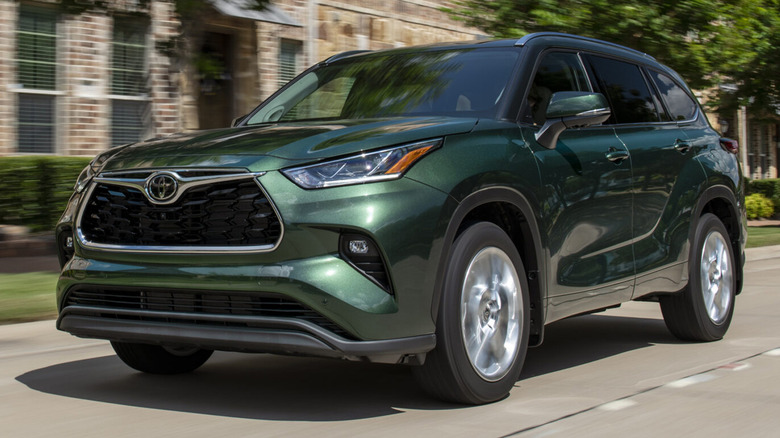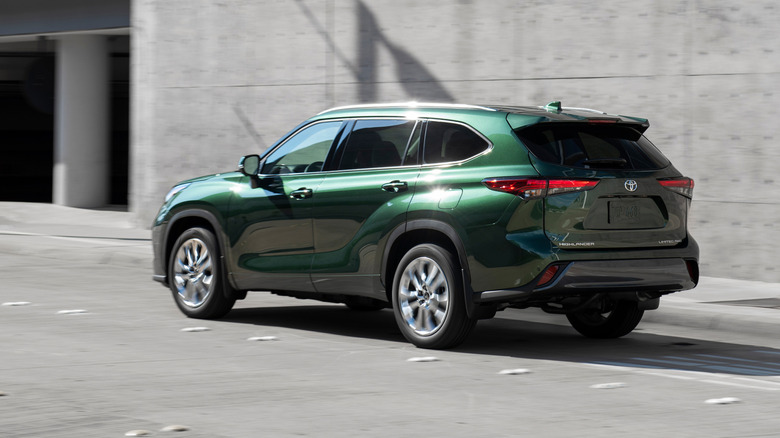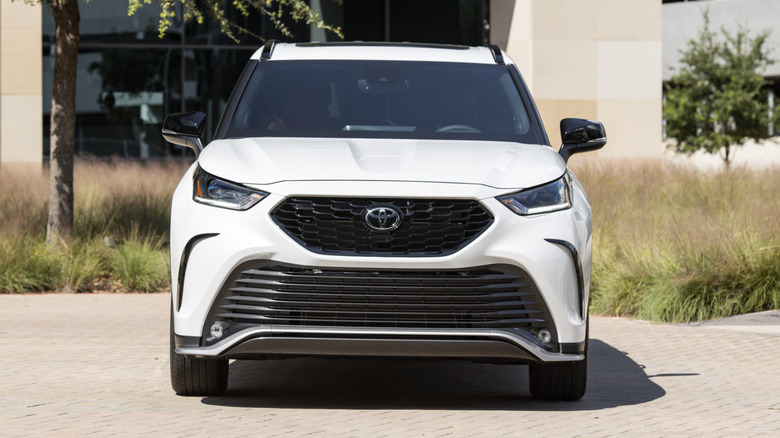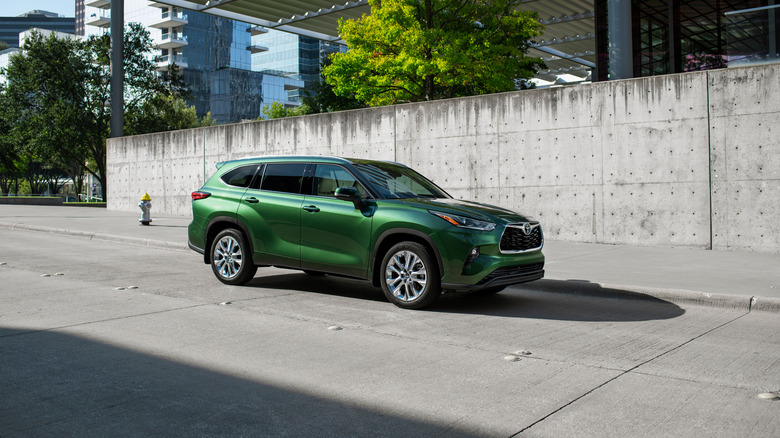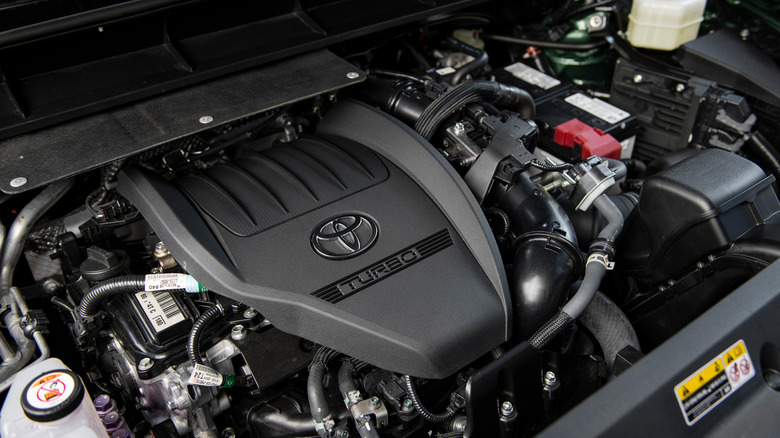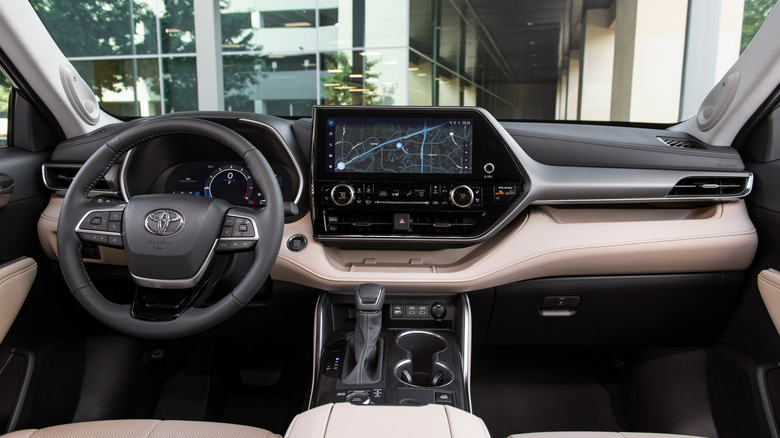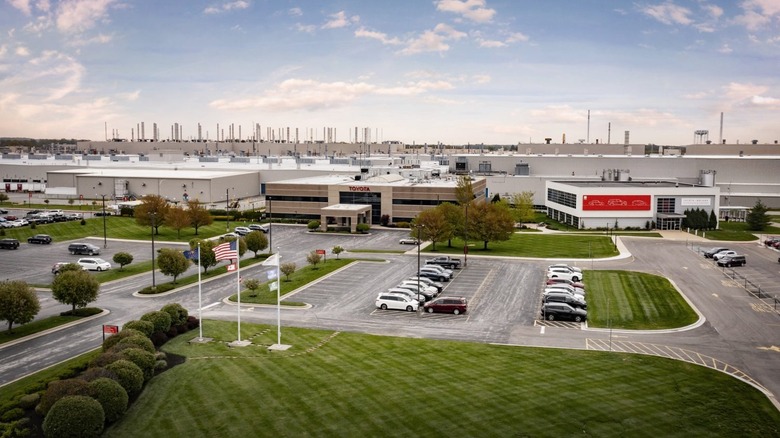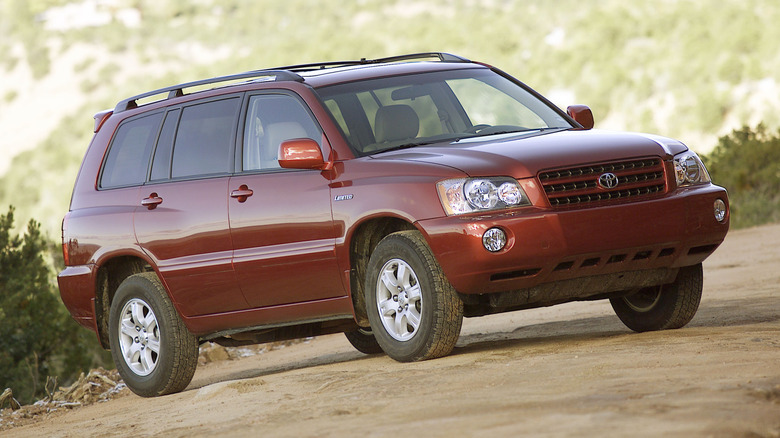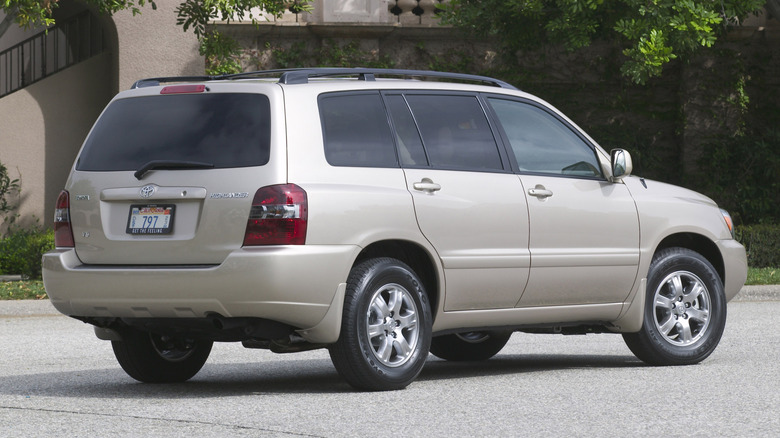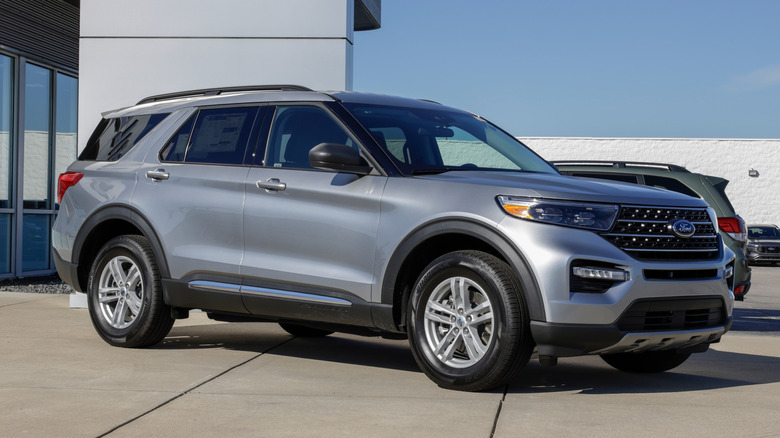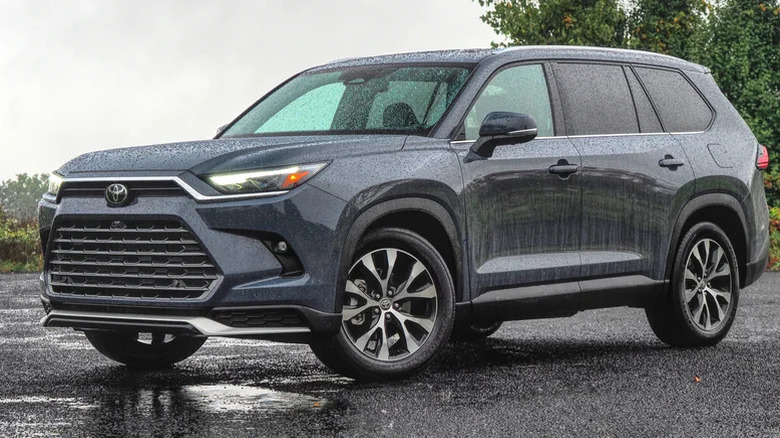10 Things You Should Know Before Buying A Toyota Highlander (New Or Used)
Toyota's SUV lineup has seen some big changes in recent years, with a number of new launches and refreshes of popular models. However, the Highlander has not been refreshed quite as recently as its peers, with Toyota instead focusing on the launch of the larger Grand Highlander. This is reflected by its sales figures, which are on a downward trend. According to CarFigures, Toyota sold over 220,000 examples of the Highlander in 2022, managed to shift just over 170,000 examples in 2023, but only sold 89,000 examples in 2024.
However, while it might not be as popular as it once was, there's still plenty to like about Toyota's long-running people mover. It's attractively priced for 2025, and thanks to the high sales figures of previous years, examples are also plentiful on the used market. In recent years, Toyota has also made some tweaks to the model that are worth knowing about, in a bid to keep buyers interested in the model. If you're contemplating whether to buy a new model or pick up a nicely depreciated example, these ten things might help you decide which option is best for you.
The 2025 Highlander starts around $40,000
For the 2025 model year, the cheapest Highlander trim starts at $39,520 excluding fees. Called the Highlander LE, it does without the extra tech and nicer upholstery of pricier models, but it still packs the same non-hybrid powertrain as higher trims. All-wheel drive is available as an option across even the lowest trims too. From there, the XLE, XSE, and Limited trims all add increasing levels of extras for a correspondingly higher price — the Limited starts from $46,775 excluding fees. The priciest non-hybrid trim is the Platinum, which adds 20-inch alloy wheels, a panoramic glass roof, and a heads-up display for $51,925 excluding fees.
The Highlander is also offered with a hybrid powertrain, with the base hybrid trim being the Hybrid XLE. It starts at $46,020 excluding fees, and is followed by the Hybrid XLE Nightshade and Hybrid Limited trims. The latter costs at least $50,475 excluding fees. A limited edition hybrid trim celebrating 25 years of the Highlander nameplate is also available for a further premium, while the Hybrid Platinum tops the range at $53,675 excluding fees.
Toyota made some changes for the latest model year
The 2025 model year Highlander was unveiled in fall 2024, and sports several small changes from the outgoing model. Chief among them is the introduction of a brand new trim, the aforementioned Hybrid Limited 25th Anniversary trim, which adds unique detailing and portobello upholstery around the interior, as well as trim-specific puddle lamps. All 25th Anniversary Highlanders receive a hybrid powertrain, and the trim starts from $52,680 excluding fees.
Changes made elsewhere in the range include the introduction of an all-wheel drive option for hybrid trims, and so every trim in the 2025 Highlander lineup can now optionally send power to all four wheels. A revised range of color options is also now available across the range. All of the Highlander's oily bits remain unchanged for 2025, with the same two powertrains available as the previous model year. Exterior styling is also carried over unchanged.
The Highlander holds its value relatively well
As well as considering its value for money upfront, most buyers will also benefit from considering how well any new car holds its value over time. No-one wants a nasty surprise when it comes time to trade their car in for a newer model, and Highlander buyers won't have any of those surprises. According to KBB's valuation tool, the Highlander is set to retain 51.7% of its value over five years.
That value retention rate is more than the average car and enough to make the Highlander one of the best performing SUVs on the market. However, retaining value over time isn't something that's unique to the Highlander — several other models in Toyota's SUV range also feature in the top performers list, including the Highlander's larger sibling, the Grand Highlander, and the off-road oriented 4Runner. Strong-selling models from Toyota rivals like Kia and Honda also make the list.
The hybrid powertrain is the most efficient choice
For the 2023 model year, Toyota replaced the Highlander's V6 engine with a smaller, more efficient turbocharged four-cylinder engine, and since then no further changes have been made to the model's powertrain options. For 2025, that 265 hp 2.4-liter turbo-four remains the base choice, while a pricier hybrid powertrain pairs a 2.5-liter four-cylinder engine with electric motors for a combined 243 hp. Power figures remain unchanged across all trims.
Buying the hybrid might result in a small horsepower loss on paper, but the added off the line torque of the electric motor and increased efficiency more than compensate for that loss. According to the EPA, the Highlander Hybrid will achieve a combined 36 mpg, making it one of the top performers in its segment. That efficiency remains consistent across different types of driving too — the agency quotes an estimated 36 mpg in the city and 35 mpg on the highway. The non-hybrid powertrain, in comparison, is rated for 24 or 25 mpg combined, depending upon which trim buyers pick.
Competitive infotainment and safety tech is available
SlashGear reviewed the Highlander after it was updated for the 2023 model year, and it has not seen any significant changes since then. That review gave the model an 8/10 rating, with our reviewing editor highlighting a few differences between the Highlander and other rivals models at the time. One key difference was the Highlander's more conservative styling compared to the Kia Telluride and Hyundai Palisade — a point that remains true even with the upcoming overhaul for the 2026 model year.
Another difference was the infotainment and safety tech included across the range. The latest iteration of the Highlander offers a marked improvement in both categories, but buyers looking for the best infotainment system will have to splash out for a higher trim. Base trims get an 8.0-inch infotainment touchscreen, with a 12.3-inch touchscreen available further up the range. Toyota offers its standard safety suite across all trims, but a number of extras including a more comprehensive suite of cameras are reserved for pricier Highlander variants.
The Highlander is manufactured in America
Despite what their respective brands may indicate, a large range of foreign cars are made in America. This range includes everything from value-oriented offerings from Kia and Hyundai to luxury vehicles from leading brands like Mercedes-Benz. However, few of those manufacturers have as long a history of making cars in America as Toyota.
The Highlander is one of a number of Toyota models manufactured in America, and the brand's domestic manufacturing history stretches back to the mid-'70s. Today, both market-specific models like the Sequoia and Grand Highlander and several popular global market models like the RAV4 and Corolla are made stateside for American customers. The Highlander is produced in the automaker's Toyota Motor Manufacturing Indiana (TMMI) facility alongside the Grand Highlander, Sienna Hybrid, and Lexus TX.
Both hybrid and non-hybrid versions of the Highlander are built in the same facility. Toyota first started work on the TMMI plant's construction back in 1996, and it opened in 1998. Manufacturing of the Highlander at the plant began in 2009, and each generation since then has been built there. All previous model years of the Highlander were built in Japan.
The nameplate was first unveiled back in 2000
The first iteration of the Toyota Highlander was different to most other SUVs on the market at the time, designed to combine the comfort and refinement of a car with the interior space of a traditional SUV. Toyota had already pioneered the idea of a so-called "crossover" with the Lexus RX, which launched in 1998, but the Highlander was a more affordable, value-oriented alternative. It debuted at the New York International Auto Show in 2000, sharing a platform and parts with the Camry.
It proved to be a sales success, and Toyota launched a second generation model in 2008. The Camry bones remained, but the Highlander got an updated range of powerplants, and was larger both inside and outside. The third generation arrived in 2014, and understandably, Toyota didn't do much to change the core formula. It proved a strong seller, and thanks to that popularity, examples remain common on the used market today. As a result, buyers can afford to be picky when it comes to finding one in good condition.
The current generation Highlander was launched for the 2020 model year, although as mentioned above, it was refreshed for 2023. Pre-2023 models have an available V6 engine, but from 2023 onward, both hybrid and non-hybrid models sport a four-cylinder engine.
Some older model years are worth avoiding
Like many Toyota vehicles, the Highlander is considered to be a generally reliable car. However, a few model years are worth avoiding, since they suffered from higher levels of recalls and owner complaints than average. According to the NHTSA's database of recalls and complaints, the most troublesome model year is the 2006 Highlander Hybrid, which has over 600 complaints as of this writing. It has also been subject to 11 recalls. Cars with higher numbers of recalls might be worth skipping for buyers looking for a safe, reliable used car, as it can be difficult to confirm that any given used example has had all the required recall work carried out.
Other poorly performing models include the 2008 Highlander and 2008 Highlander Hybrid, both of which suffer from higher levels of owner complaints than average and have over a dozen recalls each. The 2019 Highlander also has a higher rate of complaints than its surrounding model years, with over 250 logged to date. Among other issues, complainants report persistent engine warning lights, unusual noises from the transmission, and intermittent loss of power. It's worth noting that these complaints constitute only a tiny fraction of Highlander buyers, but they're still worth taking into account for any buyers looking for maximum reliability.
The Highlander competes in a tightly packed segment
While the Highlander is undoubtedly competitive in its segment, that segment is a fiercely fought one, with most major manufacturers offering at least one rival in their current lineups. Buyers looking for a domestic badge on the front of their car could consider a Ford Explorer, which remains a highly popular choice in both new and used form and can be bought new for a similar price to the Highlander.
Another long-running rival is the Honda Pilot, which remains a sensible and practical choice even if it's far from exciting to drive. South Korean automakers are also worth considering, particularly for any buyers looking for maximum value for money: The Kia Telluride and Hyundai Palisade both offer value in spades, and can get surprisingly upscale in their top-spec trims. There are plenty of other potential options from rival brands too, but as well as looking toward those other brands, buyers would also do well to consider what else Toyota has to offer in its SUV range.
Toyota's SUV lineup offers plenty of alternatives
If you're not entirely sold on the charms of the Highlander, you may not have to even leave the confines of the Toyota dealership to find what you're looking for. If interior space is the biggest consideration, the Grand Highlander offers significantly more of it for a reasonably modest bump in price. It shares a platform with the smaller Highlander, and also offers a hybrid option for buyers looking to save money at the gas pump.
Those looking for greater all-terrain capability also have options within Toyota's lineup, most notably with the 4Runner. After a decade and a half on sale, Toyota has finally refreshed the 4Runner for the 2025 model year, but has ensured that its off-road chops remain unchanged. Finally, buyers most concerned about price and willing to sacrifice interior space — and a third row of seats — could consider a RAV4. Both a hybrid and a plug-in hybrid are available for 2025, with the latter offering up to 42 miles of all-electric range.
